Variations in the Upper Ocean Heat Content of the Southern Canadian Basin
Abstract
:1. Introduction
2. Data
2.1. Ice-Tethered Profiler Data
2.2. Ocean Reanalysis Data
2.3. Word Ocean Atlas
2.4. GLORYS12V1 Data
3. Methods
3.1. Ocean Heat Content
3.2. Bi-Directional LSTM
4. Results
4.1. The Heat Content in the Upper Canadian Basin Ocean
4.2. Changes in Temperature Profiles in the Southern Canadian Basin
4.3. Prediction of the Temperature Profile Using Bi-LSTM Network
5. Discussion and Conclusions
Author Contributions
Funding
Institutional Review Board Statement
Informed Consent Statement
Data Availability Statement
Conflicts of Interest
References
- Liu, Z.; Risi, C.; Codron, F.; Jian, Z.; Wei, Z.; He, X.; Poulsen, C.J.; Wang, Y.; Chen, D.; Ma, W.; et al. Atmospheric forcing dominates winter Barents-Kara sea ice variability on interannual to decadal time scales. Cryosphere 2022, 119, e2120770119. [Google Scholar] [CrossRef] [PubMed]
- Topál, D.; Ding, Q. Atmospheric circulation-constrained model sensitivity recalibrates Arctic climate projections. Nat. Clim. Chang. 2023, 13, 710–718. [Google Scholar] [CrossRef]
- Polyakov, I.; Alekseev, G.; Timokhov, L.; Bhatt, U.; Colony, R.; Simmons, H.; Walsh, D.; Walsh, J.; Zakharov, V.F. Variability of the intermediate Atlantic water of the Arctic Ocean over the last 100 years. J. Clim. 2004, 17, 4485–4497. [Google Scholar] [CrossRef]
- Polyakov, I.V.; Pnyushkov, A.V.; Alkire, M.B.; Ashik, I.M.; Alexander, Y.L. Greater role for Atlantic inflows on sea-ice loss in the Eurasian Basin of the Arctic Ocean. Science 2017, 356, 285–291. [Google Scholar] [CrossRef] [PubMed]
- Lin, L.; Lei, R.; Hoppmann, M.; Perovich, D.K.; He, H. Changes in the annual sea ice freeze–thaw cycle in the Arctic Ocean from 2001 to 2018. Cryosphere 2022, 16, 4779–4796. [Google Scholar] [CrossRef]
- Timmermans, M.-L.; Toole, J. The Arctic Ocean’s Beaufort Gyre. Annu. Rev. Mar. Sci. 2023, 15, 223–248. [Google Scholar] [CrossRef] [PubMed]
- Shi, J.; Zhao, J.; Li, S.; Cao, Y.; Qu, P. A double-halocline structure in the Canada Basin of the Arctic Ocean. Acta Oceanol. Sin. 2005, 24, 25. [Google Scholar]
- Toole, J.M.; Timmermans, M.L.; Perovich, D.K.; Krishfield, R.A.; Proshutinsky, A.; Richter-Menge, J.A. Influences of the ocean surface mixed layer and thermohaline stratification on Arctic Sea ice in the central Canada Basin. J. Geophys. Res.-Ocean. 2010, 115, C10018. [Google Scholar] [CrossRef]
- Jean-Michel, L.; Eric, G.; Romain, B.-B.; Gilles, G.; Angélique, M.; Marie, D.; Clément, B.; Mathieu, H.; Olivier, L.G.; Charly, R.; et al. The Copernicus Global 1/12° Oceanic and Sea Ice GLORYS12 Reanalysis. Front. Earth Sci. 2021, 9, 698876. [Google Scholar] [CrossRef]
- Cheng, L.; Abraham, J.; Zhu, J.; Trenberth, K.E.; Fasullo, J.; Boyer, T.; Locarnini, R.; Zhang, B.; Yu, F.; Wan, L. Record-setting ocean warmth continued in 2019. Adv. Atmos. Sci. 2020, 2, 137–142. [Google Scholar] [CrossRef]
- Hochreiter, S.; Schmidhuber, J. Long short-term memory. Neural Comput. 1997, 9, 1735–1780. [Google Scholar] [CrossRef] [PubMed]
- Ahmed, M.; Mumtaz, R.; Anwar, Z.; Shaukat, A.; Arif, O.; Shafait, F. A multi–step approach for optically active and inactive water quality parameter estimation using deep learning and remote sensing. Water 2022, 14, 2112. [Google Scholar] [CrossRef]
- Jia, X.; Ji, Q.; Han, L.; Liu, Y.; Han, G.; Lin, X. Prediction of Sea Surface Temperature in the East China Sea Based on LSTM Neural Network. Remote Sens. 2022, 14, 3300. [Google Scholar] [CrossRef]
- Luo, Q.-R.; Xu, H.; Bai, L.-H. Prediction of significant wave height in hurricane area of the Atlantic Ocean using the Bi-LSTM with attention model. Ocean Eng. 2022, 266, 112747. [Google Scholar] [CrossRef]
- Jiang, F.; Ma, J.; Wang, B.; Shen, F.; Yuan, L. Ocean observation data prediction for Argo data quality control using deep bidirectional LSTM network. Secur. Commun. Netw. 2021, 2021, 5665386. [Google Scholar] [CrossRef]
- Polyakov, I.V.; Pnyushkov, A.V.; Carmack, E.C. Stability of the arctic halocline: A new indicator of arctic climate change. Environ. Res. Lett. 2018, 13, 125008. [Google Scholar] [CrossRef]
- Dong, J.; Jin, M.; Liu, Y.; Dong, C. Interannual variability of surface salinity and Ekman pumping in the Canada Basin during summertime of 2003–2017. J. Geophys. Res.-Ocean. 2021, 126, e2021JC017176. [Google Scholar] [CrossRef]
- Johannessen, J.; Johannessen, O.; Svendsen, E.; Shuchman, R.; Manley, T.; Campbell, W.; Josberger, E.; Sandven, S.; Gascard, J.; Olaussen, T. Mesoscale eddies in the Fram Strait marginal ice zone during the 1983 and 1984 Marginal Ice Zone Experiments. J. Geophys. Res.-Ocean. 1987, 92, 6754–6772. [Google Scholar] [CrossRef]
- Manucharyan, G.E.; Thompson, A. Submesoscale sea ice-ocean interactions in marginal ice zones. J. Geophys. Res.-Ocean. 2017, 122, 9455–9475. [Google Scholar] [CrossRef]
- Docquier, D.; Grist, J.P.; Roberts, M.J.; Roberts, C.D.; Semmler, T.; Ponsoni, L.; Massonnet, F.; Sidorenko, D.; Sein, D.V.; Iovino, D. Impact of model resolution on Arctic sea ice and North Atlantic Ocean heat transport. Clim. Dynam. 2019, 53, 4989–5017. [Google Scholar] [CrossRef]
- Sun, W.; Dong, C. Isopycnal and diapycnal mixing parameterization schemes for submesoscale processes induced by mesoscale eddies. Deep-Sea Res. II 2022, 202, 105139. [Google Scholar] [CrossRef]
- Wang, Q.; Dong, C.; Dong, J.; Zhang, H.; Yang, J. Submesoscale processes-induced vertical heat transport modulated by oceanic mesoscale eddies. Deep-Sea Res. II 2022, 202, 105138. [Google Scholar] [CrossRef]
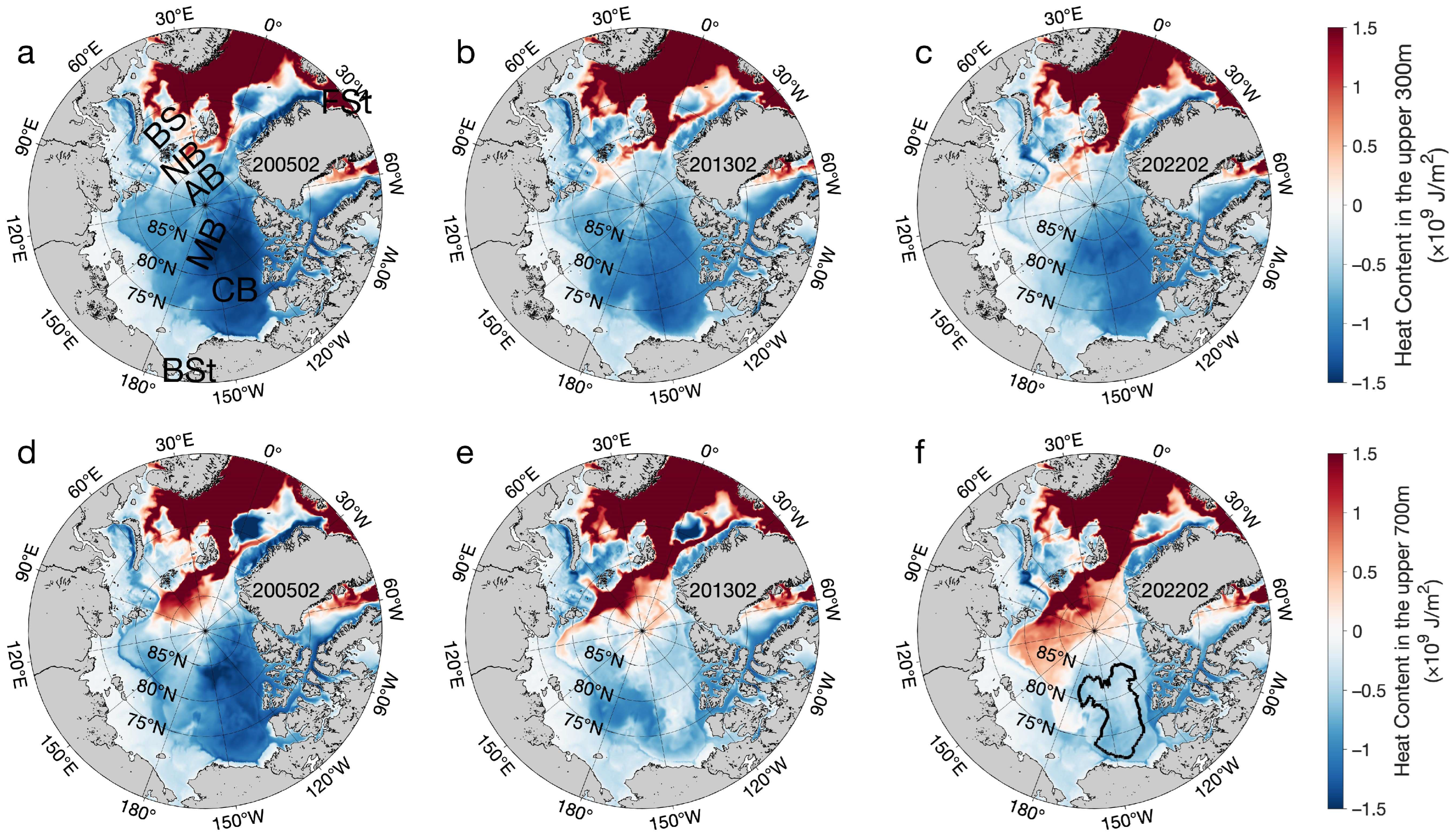

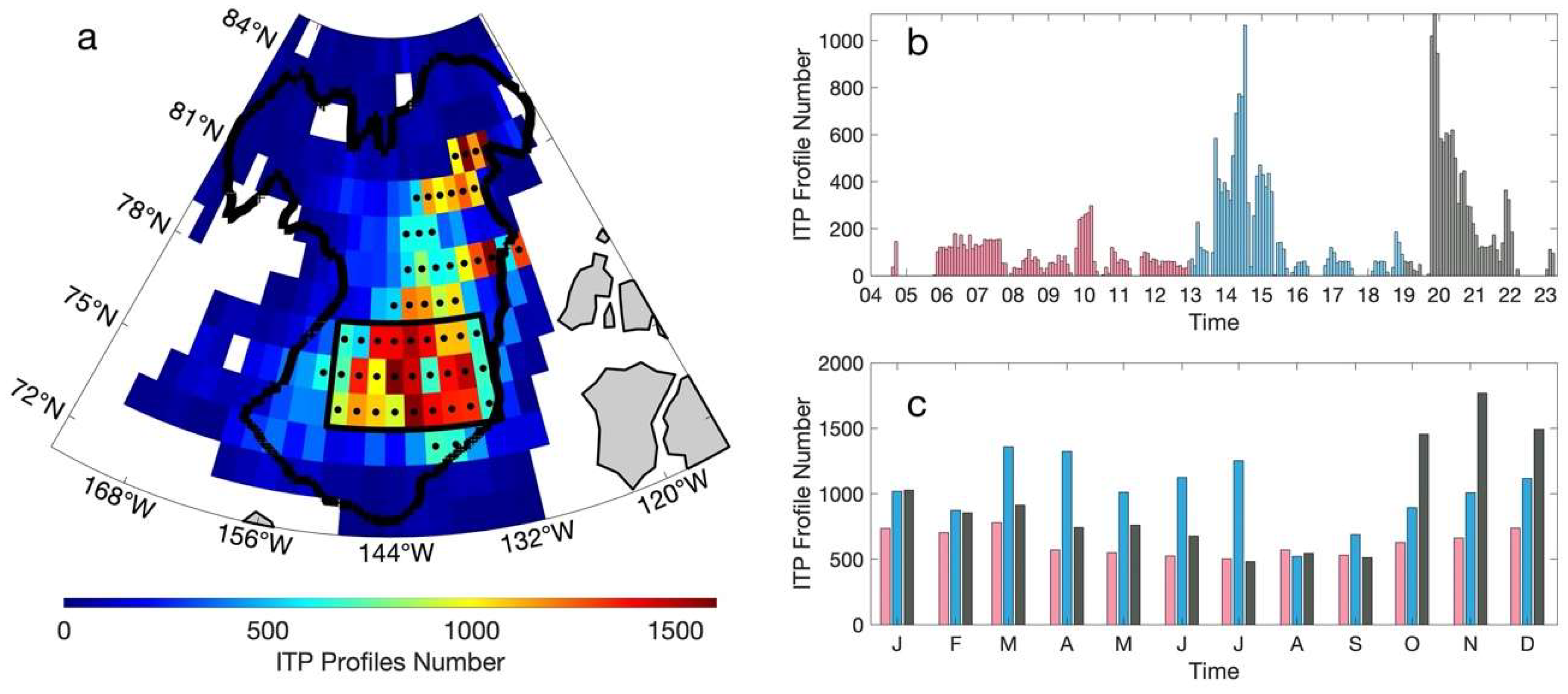

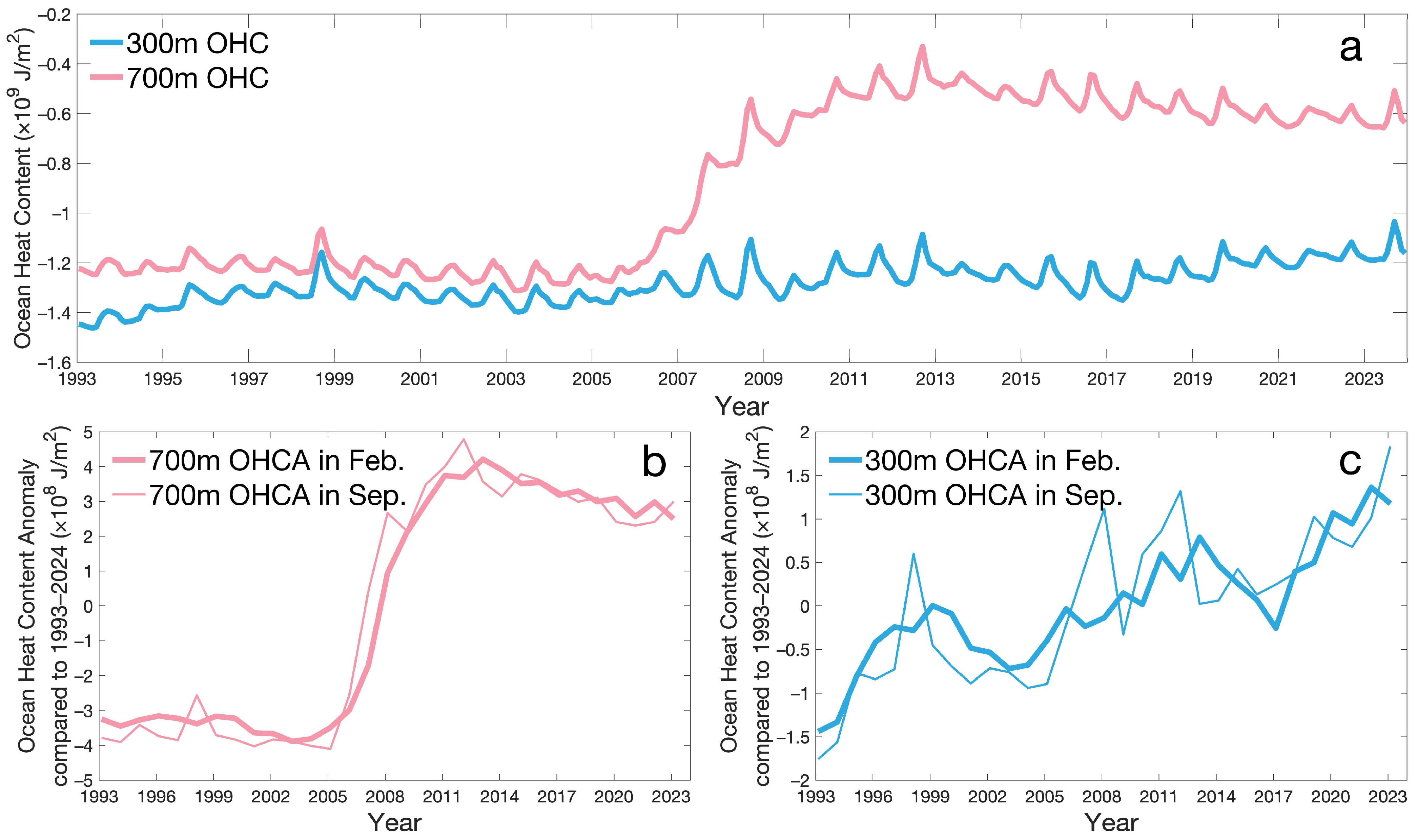
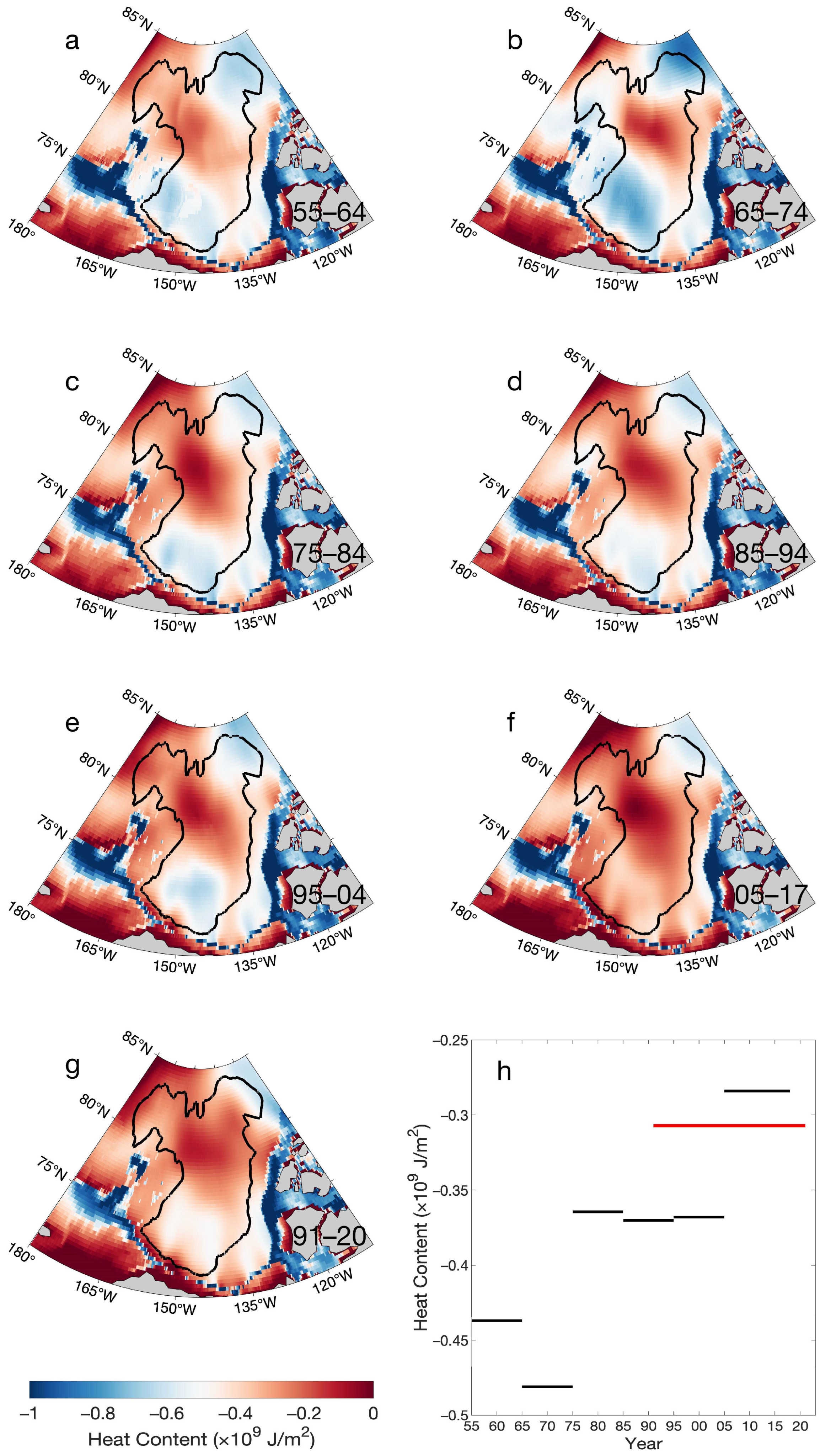
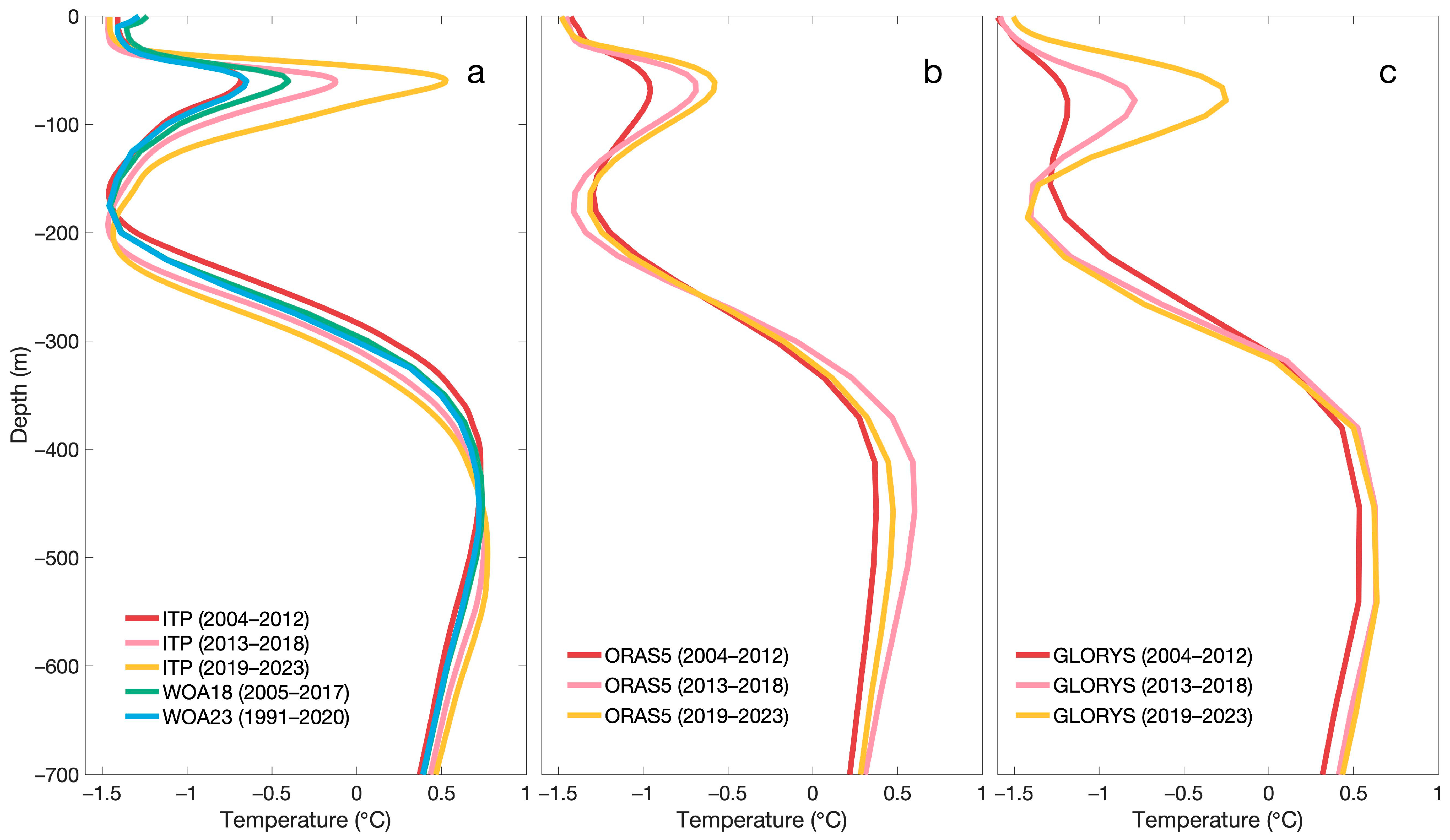
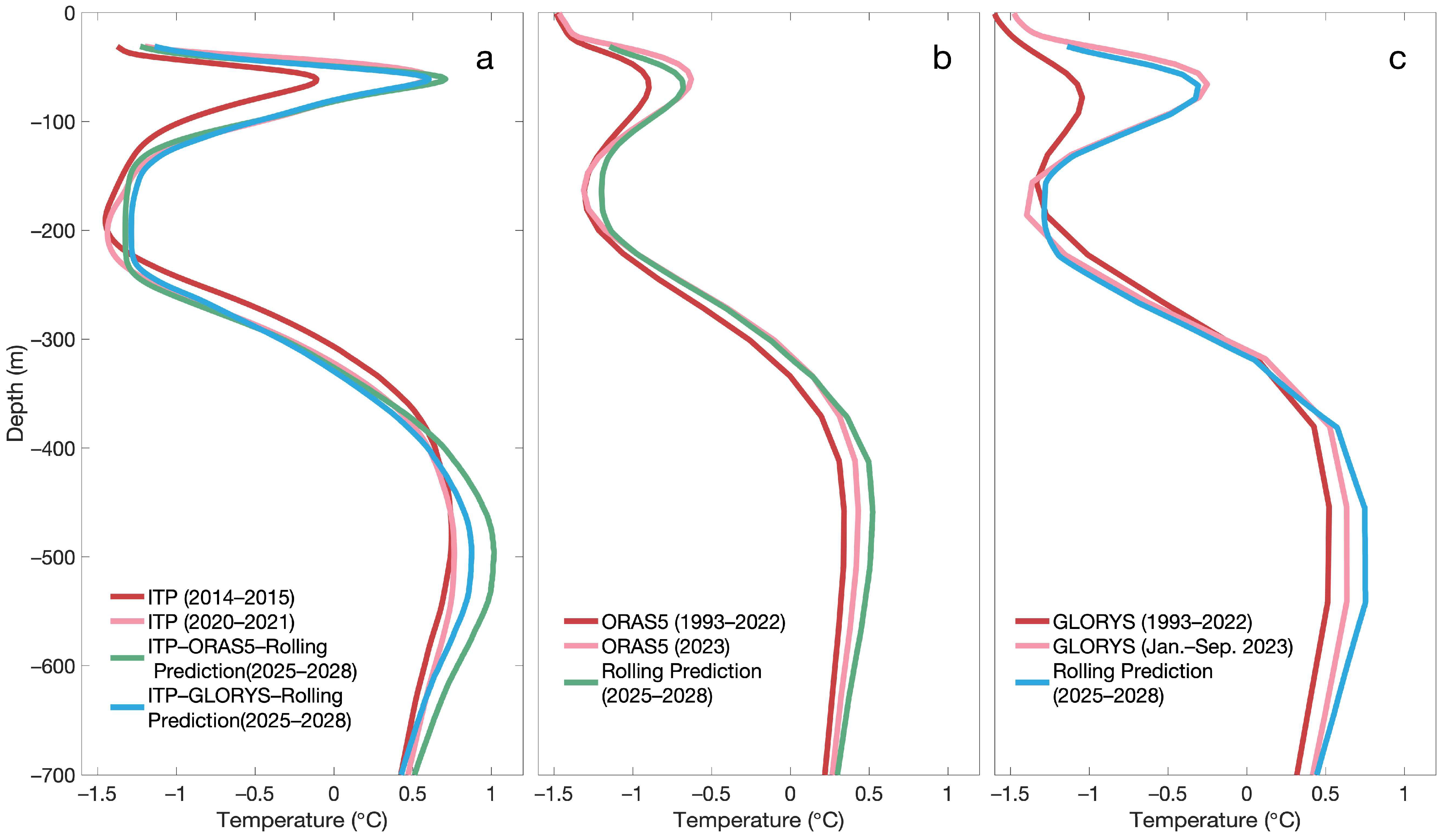
| The Usage Summary of the Ice Tethered Profilers’ Data (accessed on 27 January 2024) | |||||||||
|---|---|---|---|---|---|---|---|---|---|
| 1 | 2 | 3 | 4 | 5 | 6 | 7 | 8 | 9 | 10 |
| 11 | 12 | 13 | 14 | 15 | 16 | 17 | 18 | 19 | 20 |
| 21 | 22 | 23 | 24 | 25 | 26 | 27 | 28 | 29 | 30 |
| 31 | 32 | 33 | 34 | 35 | 36 | 37 | 38 | 39 | 40 |
| 41 | 42 | 43 | 44 | 45 | 46 | 47 | 48 | 49 | 50 |
| 51 | 52 | 53 | 54 | 55 | 56 | 57 | 58 | 59 | 60 |
| 61 | 62 | 63 | 64 | 65 | 66 | 67 | 68 | 69 | 70 |
| 71 | 72 | 73 | 74 | 75 | 76 | 77 | 78 | 79 | 80 |
| 81 | 82 | 83 | 84 | 85 | 86 | 87 | 88 | 89 | 90 |
| 91 | 92 | 93 | 94 | 95 | 96 | 97 | 98 | 99 | 100 |
| 101 | 102 | 103 | 104 | 105 | 106 | 107 | 108 | 109 | 110 |
| 111 | 112 | 113 | 114 | 115 | 116 | 117 | 118 | 119 | 120 |
| 121 | 122 | 123 | 124 | 125 | 126 | 127 | 128 | 129 | 130 |
| 131 | 132 | 133 | 134 | 135 | 136 | 137 | 138 | 139 | 140 |
| 141 | |||||||||
| Top1 | Top2 | Top3 | Top4 | Top5 | Top6 | Top7 | Top8 | Top9 | Top10 |
| Top11 | |||||||||
| No Data | Level 2 Data | ||||||||
| Level 3 Data | Top 200 m Data | ||||||||
| Maximum Temperature (Depth) | 2004–2012 | 2013–2018 | 2019–2023 |
|---|---|---|---|
| ITP-SPWW | −0.68 °C (59 m) | −0.12 °C (61 m) | 0.53 °C (59 m) |
| ITP-IAWW | 0.73 °C (427 m) | 0.76 °C (479 m) | 0.77 °C (497 m) |
| ORAS5-SPWW | −0.96 °C (69.0 m) | −0.69 °C (69.0 m) | −0.58 °C (61.1 m) |
| ORAS5-IAWW | 0.37 °C (457.6 m) | 0.60 °C (457.6 m) | 0.47 °C (457.6 m) |
| GLORYS12V1-SPWW | −1.19 °C (77.9 m) | −0.79 °C (77.9 m) | −0.25 °C (77.9 m) |
| GLORYS12V1-IAWW | 0.53 °C (453.9 m) | 0.63 °C (541.1 m) | 0.64 °C (541.1 m) |
| Maximum Temperature (Depth) | SPWW | IAWW |
|---|---|---|
| ITP (ORAS5 training) | 0.71 °C (61 m) | 1.02 °C (497 m) |
| ITP (GLORYS12V1 training) | 0.60 °C (61 m) | 0.87 °C (497 m) |
| ORAS5 | −0.68 °C (69 m) | 0.52 °C (459 m) |
| GLORYS12V1 | −0.31 °C (67 m) | 0.75 °C (537 m) |
Disclaimer/Publisher’s Note: The statements, opinions and data contained in all publications are solely those of the individual author(s) and contributor(s) and not of MDPI and/or the editor(s). MDPI and/or the editor(s) disclaim responsibility for any injury to people or property resulting from any ideas, methods, instructions or products referred to in the content. |
© 2024 by the authors. Licensee MDPI, Basel, Switzerland. This article is an open access article distributed under the terms and conditions of the Creative Commons Attribution (CC BY) license (https://creativecommons.org/licenses/by/4.0/).
Share and Cite
Liu, Y.; Ye, C.; Cen, H.; Lin, X.; Han, G. Variations in the Upper Ocean Heat Content of the Southern Canadian Basin. J. Mar. Sci. Eng. 2024, 12, 667. https://doi.org/10.3390/jmse12040667
Liu Y, Ye C, Cen H, Lin X, Han G. Variations in the Upper Ocean Heat Content of the Southern Canadian Basin. Journal of Marine Science and Engineering. 2024; 12(4):667. https://doi.org/10.3390/jmse12040667
Chicago/Turabian StyleLiu, Yu, Changcheng Ye, Haobin Cen, Xiayan Lin, and Guoqing Han. 2024. "Variations in the Upper Ocean Heat Content of the Southern Canadian Basin" Journal of Marine Science and Engineering 12, no. 4: 667. https://doi.org/10.3390/jmse12040667
APA StyleLiu, Y., Ye, C., Cen, H., Lin, X., & Han, G. (2024). Variations in the Upper Ocean Heat Content of the Southern Canadian Basin. Journal of Marine Science and Engineering, 12(4), 667. https://doi.org/10.3390/jmse12040667






